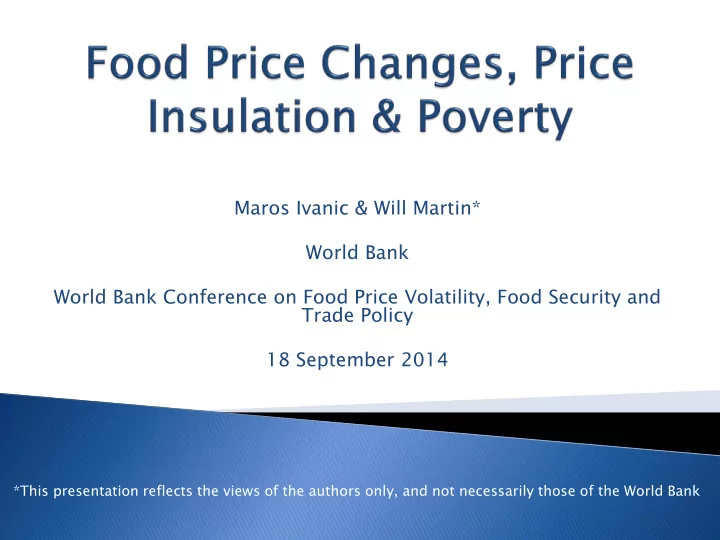

Maros Ivanic & Will Martin* World Bank World Bank Conference on Food Price Volatility, Food Security and Trade Policy 18 September 2014 *This presentation reflects the views of the authors only, and not necessarily those of the World Bank
Price insulation as policy Impacts on world & domestic prices Poverty impacts of insulation
Policy makers in many countries seem to strongly resist changes in world prices ◦ Adjust protection rates for key staples in order to avoid shocks to their prices Perhaps out of concern about the adverse impacts on poor net buyers of food when prices rise ◦ And on net sellers when prices fall? Tend to transmit longer-term price changes
2.2 2 1.8 1.6 Developing countries 1.4 World price 1.2 1 2006 2007 2008 2009 2010 2011 2012 2013
3.5 3 2.5 2 1.5 Domestic 1 World 0.5 0 2006 2007 2008 2009 2010 2011 2012 2013
3 2.5 2 1.5 Domestic 1 World 0.5 0 2006 2007 2008 2009 2010 2011 2012 2013
0.5 1.5 2.5 3.5 0 1 2 3 2006 2006 2007 2007 2008 2008 2009 2009 2010 2010 2011 2011 2012 2012 2013 World Domestic 2013
Partly an inverse relationship between world prices and protection rates ◦ With the goal of stabilizing domestic prices Also a centripetal force holding domestic prices in a stable relationship with world prices? ◦ Perhaps driven by Grossman-Helpman political- economy (PE) forces The relative strength of producers and consumers in particular industries Tending to result in high average protection in rich importers, low protection in poor exporters
700 60 Intern. Price in USD 50 600 NRA all countries 40 30 500 20 Global price NRA (%) 400 10 0 300 -10 200 -20 -30 100 -40 0 -50 Source: Kym Anderson (www.worldbank.org/agdistortions)
Governments seem averse to sharp changes in prices ◦ But also to moving too far from the Political Economy (PE) equilibrium Perhaps like an Error Correction Model? ◦ Δτ = α . Δ p w t + β [p t-1 – γ .p w t-1 ] Where τ =(p-p w ); α reflects costs of adjustment; [p t-1 – γ .p w t-1 ] is the deviation from the PE equilibrium; β reflects costs of being out of equilibrium. All variables in logs
α β Rice -0.50 -0.36 Wheat -0.52 -0.31 Sugar -0.53 -0.20 Maize -0.35 -0.44 Soybeans -0.40 -0.46 Beef -0.39 -0.31 Poultry -0.34 -0.46
Strong insulation for staples α β Rice -0.50 -0.36 Wheat -0.52 -0.31 Sugar -0.53 -0.20 Maize -0.35 -0.44 Soybeans -0.40 -0.46 Beef -0.39 -0.31 Poultry -0.34 -0.46
2.2 2 1.8 1.6 Developing countries 1.4 World price 1.2 1 2006 2007 2008 2009 2010 2011 2012 2013
Commodity No insulation Insulation Rice 2.1 5.0 Wheat 3.8 6.7 Sugar 2.7 8.2 Beef 1.6 2.3 Maize 5.1 7.4 Soybeans 3.8 4.9 Pork 0.6 0.9
Rapid price increases raise poverty because poor producers have little time to adjust ◦ And there isn’t time for wages to adjust Rapid price declines create similar vulnerabilities for producers Longer run price adjustments allow time to adjust
Countries’ own interventions tend to lower domestic prices when world prices rise ◦ Export restrictions/cuts in import duties ◦ Very consistent response across many countries But combined effect is to raise world prices ◦ If all countries do it, completely ineffective ◦ … even though it looks effective to each country But countries reacted in many different ways ◦ What was the effect on prices & poverty?
ES P w P w ES P w P 0 ED ED 0 Q
Calculate the changes in trade distortions between 2006 & 2008 for each country Calculate impacts of these changes on world & domestic prices Calculate counterfactual poverty implications ◦ Poverty impacts of each country’s own policies alone ◦ Poverty impacts of all actions
Everyone’s action Own n actions ns China 0.4 -0.6 Côte d'Ivoire 0.5 -1.8 Indonesia 0 -1.4 India 0.1 -4.2 Malawi 2.4 0.7 Niger 1.0 -0.5 Nigeria -0.9 -1.9 Tanzania 0.1 -0.3 Viet Nam -2.6 0.3 Zambia -1.9 -1.5 World (million) 8 -84
Policies such as social safety nets are individually and collectively effective ◦ There is an income effect that adds to price volatility – but this is tiny relative to insulation Need to take into account desire to insulate Can we devise rules/approaches that reduce the collective action problem?
Price increases raise poverty in short run ◦ Longer term impacts reversed by wage impacts & second- order terms Policy makers seem to insulate from world price changes in the short run ◦ But to transmit price changes within a few years Insulation reduces poverty impacts individually ◦ But appears to be collectively ineffective ◦ Need to develop policies that work
Anderson, K., Ivanic , M. and Martin, W. (2014), ‘Food price spikes, price insulation and poverty’ in Chavas, J-P, Hummels, D. and Wright, B. eds. The Economics of Food Price Volatility , , U of Chicago Press Ivanic , M. and Martin, W. (2014), ‘Implications of Domestic Price Insulation for Global Food Price Volatility’ Journal of International Money and Finance 42:272-88 . Ivanic , M. and Martin, W (2014), ‘Short - and Long-Run Impacts of Food Price Changes on Poverty’ World Bank Policy Research Working Paper 7011. Jensen, H. and Anderson, K. (2014), ‘Grain price spikes and beggar -thy- neighbor policy responses: a global economywide analysis’ Policy Research Working Paper 7007, World Bank. Martin , W. and Anderson, K. (2012), ‘Export restrictions and price insulation during commodity price booms’ American Journal of Agricultural Economics 94(2):422-7.
Recommend
More recommend